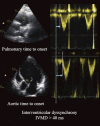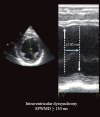Pathophysiology and Current Evidence for Detection of Dyssynchrony
- PMID: 29118878
- PMCID: PMC5667703
- DOI: 10.14740/cr598w
Pathophysiology and Current Evidence for Detection of Dyssynchrony
Conflict of interest statement
All authors have contributed and approved the final version of this manuscript. No author has any conflict of interest to disclose.
Figures








References
-
- Kapoor PM. Review of Cardiac Anesthesia and Cardiac Critical Care with 2,100 MCQs. 1st ed. New Delhi: Jaypee Brothers Medical Publishers; 2013. pp. 277–295.
-
- Bonadei I, Vizzardi E, D’Aloia A, Quinzani F, Magatelli M, Salghetti F, Curnis A. et al. [Role of echocardiography on the diagnosis is ventricular dyssynchrony in patients selected for cardiac resynchronization] Recenti Prog Med. 2013;104(2):76–79. - PubMed
Publication types
LinkOut - more resources
Full Text Sources
Other Literature Sources
